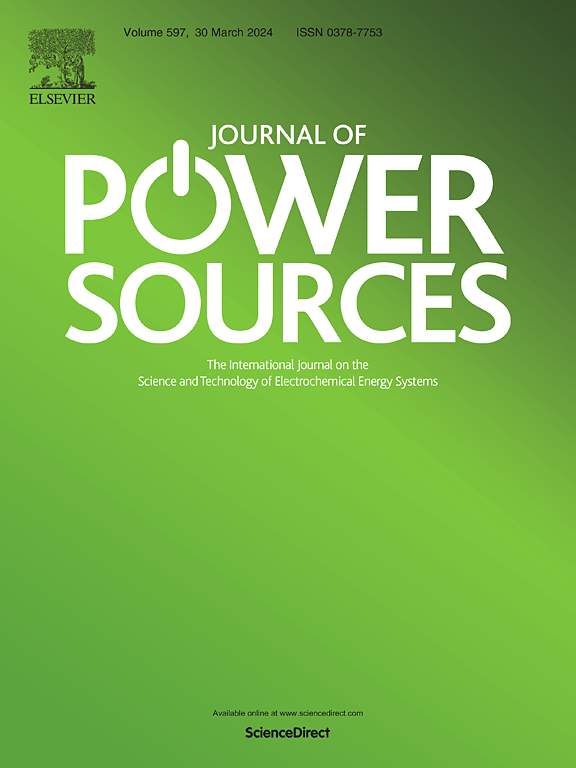Interfacial hydrogen-bonding networks of pyrene tetracarboxylic ionic liquid at Pd-electrolyte accelerate ethanol oxidation
IF 8.1
2区 工程技术
Q1 CHEMISTRY, PHYSICAL
引用次数: 0
Abstract
The hydrogen-bonding interaction among catalytic center, support material and ethanol molecule can establish an effective microenvironment for ethanol oxidation reaction (EOR). However, the surrounding of palladium nanocrystals (Pd NCs) lacks highly electronegative atoms to form hydrogen bonds with ethanol molecule. To effectively address the limitation, suitable molecules can be incorporated into Pd-based catalysts alongside the selection of an appropriate support. The pyrene tetracarboxylate ionic liquid (PTCIL), composed of pyrene tetracarboxylate anions and quaternary ammonium cations, provides abundant oxygen atoms capable of forming hydrogen bonds with ethanol molecules and the oxygen-containing functional groups in reduced graphene oxide (RGO) support, thereby creating a conducive microenvironment towards green EOR. Additionally, PTCIL can be anchored onto the RGO support via π-π stacking, yielding abundant dispersed carboxyl and pyrenyl groups that act as active sites to stabilize Pd NCs. Furthermore, synergistic interactions within the catalyst enable electron transfer from PTCIL to Pd, weakening the adsorption strength of toxic intermediates. Herein, the prepared Pd/PTCIL-RGO-2 exhibits improved electrocatalytic activity (1523.2 mA mg−1, 5.29 mA cm−2) compared to commercial Pd/C (807.2 mA mg−1, 4.14 mA cm−2). This study proposes a design for constructing Pd-based catalysts with tailored local microenvironments, exhibiting enhanced activity and robust durability for versatile applications, including EOR and other small molecule oxidation reactions.

芘四羧基离子液体在pd -电解质中的界面氢键网络加速了乙醇的氧化
催化中心、载体材料和乙醇分子之间的氢键相互作用可以为乙醇氧化反应(EOR)建立有效的微环境。然而,钯纳米晶体(Pd NCs)的周围缺乏高电负性原子,无法与乙醇分子形成氢键。为了有效地解决这一限制,可以将合适的分子结合到钯基催化剂中,同时选择合适的载体。四羧酸芘离子液体(PTCIL)由四羧酸芘阴离子和季铵盐阳离子组成,提供了丰富的氧原子,能够与乙醇分子和还原氧化石墨烯(RGO)支持下的含氧官能团形成氢键,从而创造了有利于绿色提高采收率的微环境。此外,PTCIL可以通过π-π堆叠固定在RGO载体上,产生丰富的分散羧基和芘基,作为稳定Pd NCs的活性位点。此外,催化剂内部的协同作用使电子从PTCIL转移到Pd,削弱了有毒中间体的吸附强度。本文中,Pd/PTCIL-RGO-2的电催化活性(1523.2 mA mg−1,5.29 mA cm−2)高于Pd/C (807.2 mA mg−1,4.14 mA cm−2)。本研究提出了一种基于pd的催化剂设计,该催化剂具有定制的局部微环境,具有增强的活性和耐用性,可用于多种应用,包括EOR和其他小分子氧化反应。
本文章由计算机程序翻译,如有差异,请以英文原文为准。
求助全文
约1分钟内获得全文
求助全文
来源期刊

Journal of Power Sources
工程技术-电化学
CiteScore
16.40
自引率
6.50%
发文量
1249
审稿时长
36 days
期刊介绍:
The Journal of Power Sources is a publication catering to researchers and technologists interested in various aspects of the science, technology, and applications of electrochemical power sources. It covers original research and reviews on primary and secondary batteries, fuel cells, supercapacitors, and photo-electrochemical cells.
Topics considered include the research, development and applications of nanomaterials and novel componentry for these devices. Examples of applications of these electrochemical power sources include:
• Portable electronics
• Electric and Hybrid Electric Vehicles
• Uninterruptible Power Supply (UPS) systems
• Storage of renewable energy
• Satellites and deep space probes
• Boats and ships, drones and aircrafts
• Wearable energy storage systems
 求助内容:
求助内容: 应助结果提醒方式:
应助结果提醒方式:


